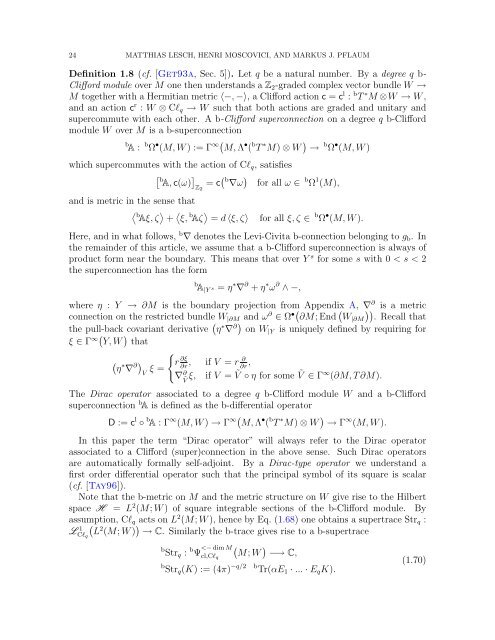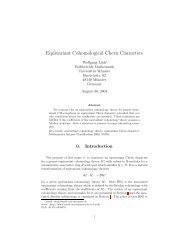Connes-Chern Character for Manifolds with Boundary and ETA ...
Connes-Chern Character for Manifolds with Boundary and ETA ...
Connes-Chern Character for Manifolds with Boundary and ETA ...
You also want an ePaper? Increase the reach of your titles
YUMPU automatically turns print PDFs into web optimized ePapers that Google loves.
24 MATTHIAS LESCH, HENRI MOSCOVICI, AND MARKUS J. PFLAUM<br />
Definition 1.8 (cf. [Get93a, Sec. 5]). Let q be a natural number. By a degree q b-<br />
Clif<strong>for</strong>d module over M one then underst<strong>and</strong>s a Z 2 -graded complex vector bundle W →<br />
M together <strong>with</strong> a Hermitian metric 〈−, −〉, a Clif<strong>for</strong>d action c = c l : b T ∗ M ⊗W → W ,<br />
<strong>and</strong> an action c r : W ⊗ Cl q → W such that both actions are graded <strong>and</strong> unitary <strong>and</strong><br />
supercommute <strong>with</strong> each other. A b-Clif<strong>for</strong>d superconnection on a degree q b-Clif<strong>for</strong>d<br />
module W over M is a b-superconnection<br />
b A : b Ω • (M, W ) := Γ ∞( M, Λ • ( b T ∗ M) ⊗ W ) → b Ω • (M, W )<br />
which supercommutes <strong>with</strong> the action of Cl q , satisfies<br />
[ b<br />
A, c(ω) ] Z 2<br />
= c (b ∇ω ) <strong>for</strong> all ω ∈ b Ω 1 (M),<br />
<strong>and</strong> is metric in the sense that<br />
〈 b<br />
Aξ, ζ 〉 + 〈 ξ, b Aζ 〉 = d 〈ξ, ζ〉 <strong>for</strong> all ξ, ζ ∈ b Ω • (M, W ).<br />
Here, <strong>and</strong> in what follows, b ∇ denotes the Levi-Civita b-connection belonging to g b . In<br />
the remainder of this article, we assume that a b-Clif<strong>for</strong>d superconnection is always of<br />
product <strong>for</strong>m near the boundary. This means that over Y s <strong>for</strong> some s <strong>with</strong> 0 < s < 2<br />
the superconnection has the <strong>for</strong>m<br />
b A |Y s = η ∗ ∇ ∂ + η ∗ ω ∂ ∧ −,<br />
where η : Y → ∂M is the boundary projection from Appendix A, ∇ ∂ is a metric<br />
connection on the restricted bundle W |∂M <strong>and</strong> ω ∂ ∈ Ω •( ∂M; End ( ))<br />
W |∂M . Recall that<br />
the pull-back covariant derivative ( η ∗ ∇ ∂) on W |Y is uniquely defined by requiring <strong>for</strong><br />
ξ ∈ Γ ∞( Y, W ) that<br />
(<br />
{r η ∗ ∇ ∂) ∂ξ<br />
ξ = , if V = r ∂ ,<br />
∂r ∂r<br />
V<br />
∇ ∂ ξ, if V = Ṽ ◦ η <strong>for</strong> some Ṽ ∈ Ṽ Γ∞ (∂M, T ∂M).<br />
The Dirac operator associated to a degree q b-Clif<strong>for</strong>d module W <strong>and</strong> a b-Clif<strong>for</strong>d<br />
superconnection b A is defined as the b-differential operator<br />
D := c l ◦ b A : Γ ∞ (M, W ) → Γ ∞( M, Λ • ( b T ∗ M) ⊗ W ) → Γ ∞ (M, W ).<br />
In this paper the term “Dirac operator” will always refer to the Dirac operator<br />
associated to a Clif<strong>for</strong>d (super)connection in the above sense. Such Dirac operators<br />
are automatically <strong>for</strong>mally self-adjoint. By a Dirac-type operator we underst<strong>and</strong> a<br />
first order differential operator such that the principal symbol of its square is scalar<br />
(cf. [Tay96]).<br />
Note that the b-metric on M <strong>and</strong> the metric structure on W give rise to the Hilbert<br />
space H = L 2 (M; W ) of square integrable sections of the b-Clif<strong>for</strong>d module. By<br />
assumption,<br />
(<br />
Cl q acts on L 2 (M; W ), hence by Eq. (1.68) one obtains a supertrace Str q :<br />
LCl 1 q L 2 (M; W ) ) → C. Similarly the b-trace gives rise to a b-supertrace<br />
b Str q : b

















